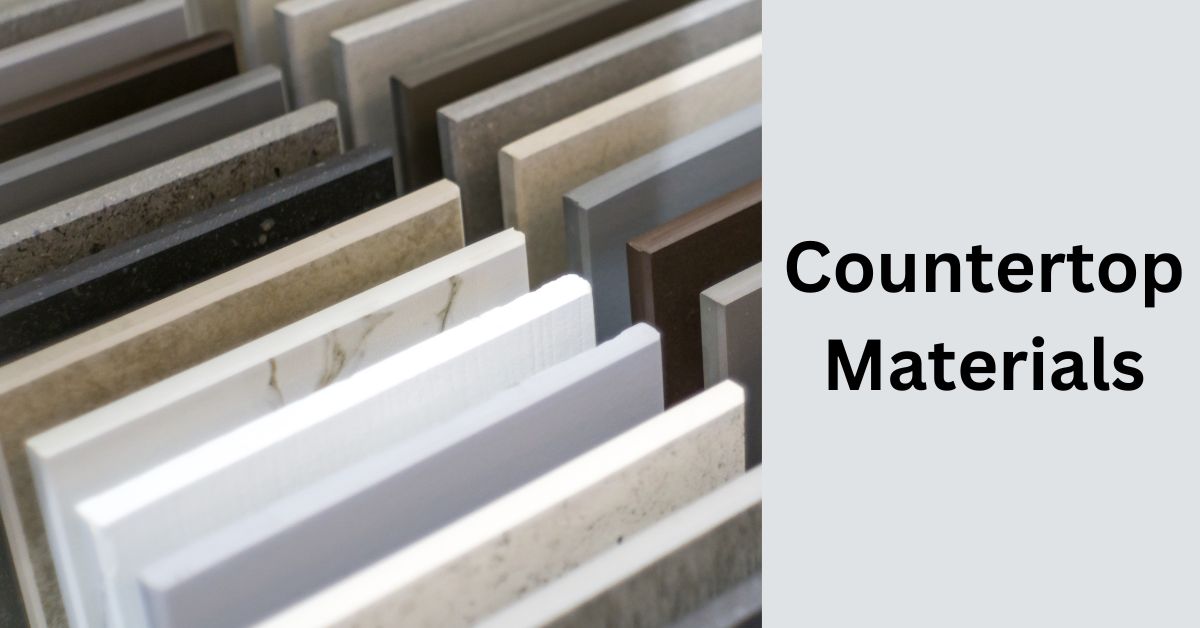Table of Contents
Note: If you came to this post on countertop materials through a random search, please click on this parent page and our home page for more context.
About Countertop Materials
Here we lay out the pros and cons of the wide variety of countertop materials available to us. And we will give our opinion on each.
A great deal of this depends upon individual personal aesthetic preference. But there are practical consequences to our decision-making in this area that need to be weighed too.
Factors to Consider
- Aesthetics: Beauty is indeed in the eye of the beholder. But you have to try to be an objective beholder.
- Cost vs value: Here we balance the cost of materials and installation against value measured against two standards. First, is the result really worth the money? And, second, would it help or hinder a potential future sale of the property?
- Ease of use: Is the material easy to maintain? Will it stain? Is it easy to clean? Does it offer an even surface?
- Durability: Is it impact and heat-resistant?
Let’s take a look at the main countertop materials available and make some recommendations.
Tile Countertop
We’ll say at the outset: stay away from tile countertops. These were all the rage in the 1980s before better materials became readily available.
Ceramic or porcelain tile is the go-to DIY choice for countertops because they are cheap and easy to install. But don’t be tempted to do it.
The grout lines are hard to keep clean and it is virtually impossible to get a totally smooth surface that things will not wobble on.
The tile itself is very stain resistant but the grout definitely is not.
So, while tile is definitely fine for backsplashes (provided you use very narrow grout lines), it is bad for countertops. And a tile countertop will definitely turn off a prospective buyer. A tile countertop may be cheap to install but it will cost you big in the long run.
Wood Countertop
There are two main types of wood countertop material: reclaimed wood and butcher block.
Reclaimed wood is wood that has been salvaged from old construction, such as a demolished barn or a bowling alley. It is usually used in its plank form. Being recycled, it has a Green appeal.
Regular butcher block is fabricated from routinely harvested woods like maple, oak, and cherry. The wood is straight-cut and glued. It can use reclaimed wood as its raw material.
Wood is quite popular because it has an engaging “country” or “antique” look and has good longevity. But its appeal is not universal and it has at best a neutral resale value.
Although it is reasonably heat resistant, it is still wood and easily prone to surface damage by scratches and nicks. Plus its finish has to be maintained and resealed regularly or it will suffer water damage and staining over the long term. Other than that it is durable and long-lasting.
Wood countertops are not cheap. And because of their relatively limited appeal and high maintenance profile, we would not recommend them.
Laminate Countertop
Laminate countertops have come a long way from the tacky-looking old days of Formica. They now look very good. But, as they say about beauty, these looks are only skin deep.
Laminate is easy to clean and has quite good impact and heat resistance but it is vulnerable to intense heat and easily scratched and chipped. Minor dings can be fixed with a matching resin paint. But you can’t fix anything major. And any delamination makes the whole thing a lost cause.
So the lifespan of laminate is limited and its appeal on resale is actually negative. No matter how attractive modern laminate material is, it will never outlive its stigma of cheap tackiness.
Although laminate is an inexpensive countertop material, we do not recommend it at all. It is better to save on other items in your remodel budget and spend the savings on better countertops
Concrete Countertop
It is a surprise to many people that concrete countertops even exist. But it has become a contemporary “thing” in some circles. However, in our opinion, it is a trendy fad and has too many downsides to last.
- Related post: Fad vs Trend
The concrete comes in a variety of colors and tones, depending on the tinting that is used in the concrete mix. And it can certainly look good, especially because the concrete gets poured and formed in place as a monolithic whole. This means that the countertop has no seams. And in our view, this is the best thing it has going for it.
It is also a surprise to find out how expensive a concrete countertop can be. This is because, although the material itself is cheap, its fabrication is difficult and very labor-intensive. And the concrete requires specialty additives.
There are also maintenance issues with this material. It can be easily stained and heat can scorch it. And there are no easy fixes for this that we are aware of.
As to value, a potential buyer may well be turned off by a concrete countertop unless it fits well into a contemporary kitchen design.
So our bottom line recommendation is to stay away from concrete countertops. They are faddish.
Zinc Countertop
Zinc is another rather surprising material to find as a countertop. And we would put it in the same faddish category as concrete. Nonetheless, although uncommon it does have its appeal in some quarters.
Zinc has a dull gray appearance and develops a unique patina over time and this has its own appeal.
As to durability and maintenance, zinc is a metal and is impervious to the heat of hot cookware. But it is a soft metal and easy to scratch. And, while easy to clean, zinc is prone to discoloration by some household products, such as vinegar.
As to value, a zinc countertop is an expensive item that will not have commensurate appeal on resale. In fact, it is likely to put many buyers off.
So our recommendation is to stay away from zinc countertops.
Stainless Steel Countertop
We put stainless steel countertops in the same category as zinc and concrete as a trendy application that is pretty faddish.
The domestic stainless steel countertop originated in commercial kitchens. This is for the simple reason that it is highly durable, impervious to heat, and easy to clean.
For us, the stainless steel sink is a wonderful thing because it is so durable and easy to maintain. And its limited application as a sink can let stainless steel make a design statement.
But there is no reason to spread the material all over the kitchen because it becomes overwhelming. Of course, that is just our negative opinion but we are certain it is not unique and will be shared by many potential buyers.
On top of that, stainless steel is expensive. This is not so much in the cost of the material, which is already quite high. But rather in the cost of the fabrication, which is a highly specialized endeavor.
So, our recommendation is to stay away from stainless steel countertops, unless this is your thing.
Synthetic Solid Surface Countertop
The synthetic solid surface countertop has Corian as its most recognized brand name. It is a proprietary formulation made of acrylics, polyester resins, epoxies, and pigments. It comes in many different looks and styles.
It is made to resemble and compete with higher-end countertop materials like granite and quartz, although it will never compete with those products in looks. It is stain and germ-resistant and it is easy to buff out any accidental scratches. But, although generally easy to maintain, it is vulnerable to heat.
It can be made to be seamless and can incorporate seamless sinks of the same material. It does not compete well with granite or quartz for looks but does well against other countertop materials. It certainly has a great deal more curb appeal and resale value than tile and laminate. We would say that it ranks about even with wood.
In our opinion, a solid synthetic surface, such as Corian, makes a good, economical countertop. Overall, it comes in third after granite slab and quartz.
Granite Slab Countertop
Granite is a natural “unprocessed” stone cut as a thin slab from a larger piece of granite in a stone quarry. It is then polished. The slab is further cut by the countertop fabricators to conform to the layout of your kitchen counter.
The appearance of granite is deep and rich. This makes it preferred as a countertop material over other natural stones, such as marble, soapstone, and slate. Also, compared to marble and soapstone, it is much less prone to staining.
And, just by the way, never use marble as a countertop. A single, accidental spill of red wine can ruin it.
Granite is indeed porous and susceptible to staining but routine sealing will prevent this from being a problem. Also, granite is pretty much impervious to heat.
Overall, a granite slab is probably the most expensive countertop material out there. But it looks great and has excellent resale value.
Quartz Countertop
Quartz countertops are engineered stone. They contain natural quartz fragments and other natural stone byproducts. These are ground into powder and mixed with resins to form slabs.
These countertops come in many formulations resulting in multitudes of patterns and colors. However, unlike granite or other natural stone slabs, which contain natural variations, they have a uniform appearance.
Quartz countertops have pretty much all the positive attributes of natural granite slabs but on average cost less. And, unlike natural stones, they are entirely uniform in appearance and do not have cracks or other irregularities. Quartz is highly resistant to staining and heat, which makes it very low maintenance.
Quartz is at the high end of cost but, depending on the product comparison, is generally less expensive than granite slab. It has excellent resale value.
Our Overall Verdict on Countertop Materials
In our opinion quartz and granite slabs come out on top close together. The preference for one over the other is mainly one of feelings and aesthetics.
With a granite slab, you have a unique piece of Nature’s art. No two granite slabs are alike. Even the one that was cut from the same rock as the next is going to be slightly different.
So, if you come across a granite slab that you just love, go for it. Your only risk is that sometime in the future you will find a slab that you would love better.
On the other hand, with quartz, you have a huge choice right off the bat and you can make a rational and informed selection choice based on what is right in front of you. Plus, aesthetics aside, quartz has the edge from the point of view of durability and maintenance.
Overall, since the countertop is such a dominant part of the appearance of the kitchen, it is well worth making any necessary adjustments in the overall budget to end up with granite or quartz, or at least a Corian-type product.
- Related post: Integrated Countertop and Sink
- Related post: Kitchen Design Trends
- Related post: Bathroom Design Trends
- Related post: Kitchen Sinks





Leave a Reply